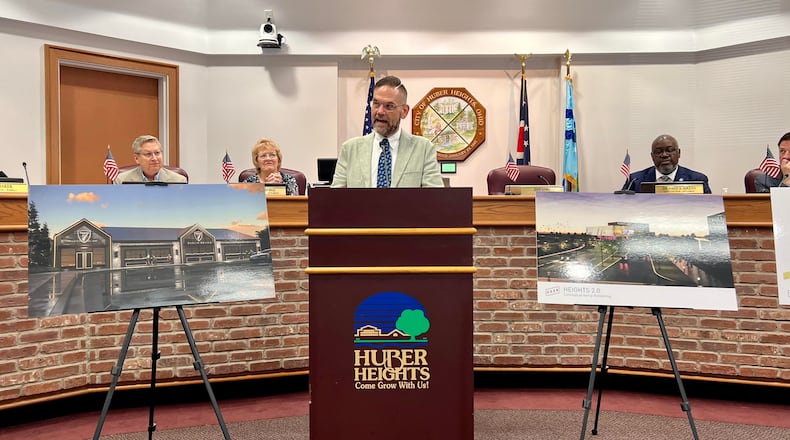Gore first announced the possibility of a second music venue in the blossoming Executive Boulevard area nearly a year ago.
More concrete plans were shared Monday, including that the venue will accommodate up to 3,500 guests and will feature performance spaces, VIP lounges, bars, concessions, and “flexible configurations” to host private events and corporate functions, along with concerts.
“This venue will serve as a cultural and economic anchor for our growing entertainment district, and a general destination for live entertainment, business, and celebration,” Gore said during Monday’s Huber Heights State of the City address.
The venue, to be called Heights 2.0, is expected to open in 2028.
A new Dublin Pub location, to be called Dublin Seven, is expected to open nearby on Executive Boulevard, closer to the Rose Music Center, in time for St. Patrick’s Day 2027.
Dublin Seven will feature a pub and accompanying 5,891-square-foot beer garden, with the capacity to host live music and a large annual St. Patrick’s Day celebration, Gore said.
“This development will solidify Huber Heights as a regional destination for entertainment and hospitality,” he said. “It will create jobs, support local tourism, and further energize our thriving entertainment core.”
Gore also announced plans for a new hotel on Executive Boulevard, to be constructed on a site adjacent to the new music venue.
The full-service hotel will feature two restaurants, offering Italian and Indian fare, respectively, along with classroom and meeting space.
The hotel’s operating brand will be disclosed when details are finalized, Gore said.
Credit: Tom Gilliam
Credit: Tom Gilliam
Two previously announced residential developments will also join the rapidly growing corridor. This includes a 300-apartment development along with 11,000 square feet of retail space north of TJ Chump’s, which sits between The Rose and Meijer. Another 312-apartment complex called Reverb will be built to the west of that.
Gore’s speech highlighted other areas of growth in the city as well, like a solid increase in population, according to the most recent census, to more than 43,000 total residents.
“One of the most impressive economic indicators based on data through just 2023 is that our median household income has risen more than 28% to over $76,000, demonstrating strong local purchasing power,” he continued.
The city welcomed 30 new businesses in 2024, and 22 more have opened since the start of this year, Gore said.
“Businesses now have confidence that locating or growing in Huber Heights is a smart business decision,” he said.
Monday’s development announcements come nearly a month after city council voted to issue just under a dozen bond notes, totaling nearly $90 million in debt securities for various projects throughout the city.
This included a $5 million bond note issuance for a proposed project vaguely described at the time as a new “multi-purpose facility.”
Credit: Tom Gilliam
Credit: Tom Gilliam
Gore clarified to the Dayton Daily News on Monday that the $5 million bond is related to the planned indoor music venue, a detail city officials declined to confirm when asked directly in May.
“We weren’t ready to talk (publicly) about it,” Gore said following Monday’s address. “There’s a lot of moving pieces to how all this is coming together and those pieces weren’t all together last month.”
Much of this behind-the-scenes work for projects like the new music venue and others involves coordinating and obtaining long-term funding security, which Gore said needed to be done prior to sharing specifics.
The city utilizes funding mechanisms like the transformational mixed-use development program, which provides a tax credit against development costs incurred during the construction of a project that will be a catalyst for future development in the area, as well as tax increment financing (TIF), an economic development tool to help finance public infrastructure improvements.
“When we talk about TIF funds, that’s the portion of property taxes that the county rebates back to the city to help with infrastructure and economic growth; that’s what pays for these (projects), not individual taxpayer money,” he said. “There has never been a single penny of income tax paying for the Rose, and there won’t be a single penny of income tax paying for the new music center.”
About the Author



